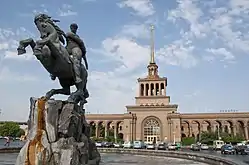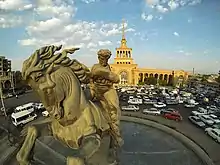Sasuntsi Davit (statue)
Sasuntsi Davit (Armenian: Սասունցի Դավիթ) is a copper equestrian statue depicting David of Sassoun (Sasuntsi Davit) in Yerevan, Armenia. Erected by Yervand Kochar in 1959, it depicts the protagonist of the Armenian national epic Daredevils of Sassoun.
.JPG.webp) | |
| Coordinates | 40.155296°N 44.509418°E |
|---|---|
| Location | Sasuntsi Davit Square (Railway Station Square), Erebuni, Yerevan, Armenia |
| Designer | Yervand Kochar (sculptor) Mikayel Mazmanian (architect) |
| Material | Copper (sculpture)[1] Basalt (base) |
| Height | 12 metres (39 ft)[2]:20 |
| Opening date | December 3, 1959 |
| Dedicated to | David of Sassoun |
History
Background
The idea to erect a statue to David of Sassoun, the epic hero of the national epic Daredevils of Sassoun, emerged in the late 1930s since the one thousandth anniversary of the epic was celebrated in Soviet Armenia in 1939. The authorities decided to have a statue to David of Sassoun be erected in the square in front of the Yerevan Railway Station to greet the visitors of Yerevan, since the majority of visitors to Yerevan came by train at the time. Yervand Kochar was selected to create a statue of the epic hero. It took him 18 days to create the statue in gypsum. The statue was destroyed in 1941 days after Kochar was arrested for supposedly praising Adolf Hitler.[3][2]:28
Current statue
In 1957, on the 40th anniversary of the October Revolution, the Yerevan authorities decided to restore the statue. Kochar recreated the statue to David of Sassoun with significant changes from the 1939 original. The latter included an old Arab man besides David. The restored (current) statue was inaugurated on December 3, 1959.[4] None of the top officials of the local Communist Party attended the ceremony. It was largely attended by Armenians who were from the Sasun (Sassoun) area, or descended from them.[3]
Restoration
In the post-Soviet period the statue deteriorated somewhat and the "cup of patience", located at the feet of the horse, was stolen․ It was recovered in 2011.[2]:p. 1 That year, the statue underwent general restoration, which was funded, primarily, by Ruben Vardanyan.[3] The pool around the statue was also restored and the Railway Station Square cleaned.[2]:18 However, in 2012 several sculptors said the statue needed further restoration.[5]
Proposals to move
In the post-Soviet period, some have proposed to move the statue to Republic Square, where the statue of Lenin used to stand.[2]:34 Architect Garri Rashidyan, for instance, wrote in his 2007 book that it may be the "best solution for replacing Lenin as the central and focal point of the most important square of our republic." According to Diana Ter-Ghazaryan, David of Sassoun would be a safe choice because of the epic hero's fundamentally apolitical nature and his statue at Yerevan's central square would be acceptable by most Armenians. However, writing in 2013, she considered the relocation unlikely.[6]
Reception
The statue has been widely admired by critics and visitors alike. Architectural historian Murad Hasratyan called it Kochar's masterpiece.[7] In 1980 Ara Baliozian noted that the "splendid" statue has "acquired archetypal dimension."[8] It has become a symbol of Yerevan and a landmark of Armenia.[9] Rouben Paul Adalian noted that the "dynamic and forceful" statue is "such a compelling work of sculpture that the image became an emblematic portrait of the Soviet Armenian republic."[10]
Another author noted that Kochar created a "lasting and powerful national value" due to his "ability to draw from the universal pool of knowledge and culture." The statue is the "condensed power of Armenia, but it is also an extension of the same power that gave birth to Michelangelo’s David."[11] Soviet travel writer Nikolai Mikhailov praised the statue's expression of impetuousness.[12]
An online poll by Yerevan Magazine found that Sasuntsi Davit is the most beloved statue of the residents of Yerevan.[2]:17 Many authors have called it Yerevan's best statue.[13]
The film studio Hayfilm (formerly Armenfilm) uses the statue as its logo.
Gallery
References
- "David of Sasun". kochar.am. Ervand Kochar Museum. Archived from the original on 3 January 2021.
- Yeghiazaryan, Artavazd, ed. (September 2014). "Արձանագրություն" (PDF). Yerevan Magazine (in Armenian). 9 (27). Archived from the original (PDF) on 3 January 2021.
- "Կայարան ու Սասունցի Դավիթ' կենդանի պատմություն". mediamax.am (in Armenian). 27 June 2012. Archived from the original on 3 January 2021.
- Editorial (1959). "Սասունցի Դավթի արձանի բացումը". Etchmiadzin (in Armenian). 16 (12).
- Mkrtchyan, Anush (15 June 2012). "Արվեստագետներին մտահոգում է "Սասունցի Դավիթ" արձանի վիճակը". azatutyun.am (in Armenian). RFE/RL. Archived from the original on 3 January 2021.
- Ter-Ghazaryan, Diana K. (2013). ""Civilizing the city center": symbolic spaces and narratives of the nation in Yerevan's post-Soviet landscape". Nationalities Papers. 41 (4): 570–589. doi:10.1080/00905992.2013.802766.
- Hasratyan, Murad (2009). "Արարատ Աղասյան. Հայ կերպարվեստի զարգացման ուղիները XIX-XX դարերում, Երևան, "Ոսկան Երևանցի" հրատ., 2009 [Ararat Aghassyan. The Ways of the Development of Armenian Fine Arts of the 19th – 20th Centuries]". Patma-Banasirakan Handes (in Armenian) (2–3): 274.
Քոչարի գլուխգործոց Սասունցի Դավթի արձանին
- Baliozian, Ara (1980). The Armenians: Their History and Culture. New York: AGBU Ararat Press. p. 151.
- Bedevian, Ruth (15 February 2007). "Yervand Kochar - Incomparable Talent Evoked the National Spirit of Armenia". Armenian News Network / Groong. University of Southern California. Archived from the original on 10 May 2020. Retrieved 28 February 2014.
- Adalian, Rouben Paul (2010). Historical Dictionary of Armenia. Lanham, Maryland: Scarecrow Press. p. 191. ISBN 978-0-8108-7450-3.
- Kochar, Yervand (14 November 2010). "Komitas and Kochar: The Music and Image of Undefeated Spirit". Armenian Weekly. Archived from the original on 3 January 2021.
- Mikhailov, Nikolai (1983). Panorama of the Soviet Union. Moscow: Progress Publishers. p. 196.
By the new station you will see a romantic monument of hammered bronze to the folk hero of olden times, David of Sasun by the sculptor Kochar. He is depicted with a sword on horseback, and the statue is mounted on a basalt slab. Nowhere have I seen impetuousness so well as in this sculpture.
- Ishkhanyan, Avetik (1 July 2019). "Երկու արձան [Two statues]". Hetq (in Armenian). Archived from the original on 1 July 2019.
Շահումյանի արձանը լավագույնն է Երևանի բոլոր արձանների մեջ (չհաշված Երվանդ Քոչարի Սասունցի Դավիթը)։
.jpg.webp)
.JPG.webp)



.JPG.webp)